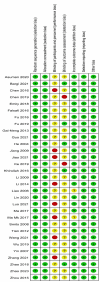Effectiveness of different exercise interventions on depressive symptoms among college students: a network meta-analysis
- PMID: 40389939
- PMCID: PMC12087167
- DOI: 10.1186/s12889-025-22904-z
Effectiveness of different exercise interventions on depressive symptoms among college students: a network meta-analysis
Abstract
Background: Depression affects approximately 25% of college students globally. Physical exercise shows promise as a low-cost, high-adherence intervention for depression, but research comparing different exercise types is lacking. This study aims to evaluate the efficacy of various exercise interventions in alleviating depressive symptoms among college students through a network meta-analysis, to inform targeted exercise prescriptions.
Methods: We conducted a systematic search of six databases (PubMed, Web of Science, Cochrane Library, EMBASE, SCOPUS, and ScienceDirect) from their inception to July 1, 2024. Interventions were classified into six categories based on exercise type and intensity. Data extraction and systematic analysis were performed using Review Manager 5.4. A network meta-analysis was conducted using Stata 14.0, with heterogeneity assessed via node-splitting models, and results presented as standardized mean differences (SMD) and 95% confidence intervals (CI).
Results: Forty-two randomized controlled trials involving 1,169 participants were included. The network meta-analysis revealed that Special Training Unit (STU), Dynamic Resistance Movement Group (DRMG), and Aerobic Exercise Group (AEG) demonstrated high effectiveness in improving depressive symptoms. STU showed the highest probability of being the most effective intervention (65.1%), followed by DRMG (64.8%), AEG (61.3%), and Strength and Resistance Training Group (SRTG) (60.9%). High-Intensity Training Group (HITG) (26.2%) and Moderate Intensity Group (MIG) (21.7%) showed less impact on improving depressive symptoms. The limited effectiveness of HITG may relate to excessive physiological stress responses, while MIG potentially provided insufficient stimulation to trigger optimal neurobiological adaptations for mood improvement.
Conclusions: Special Training Units (STU) and Dance and Rhythmic Movement Group (DRMG) interventions demonstrate superior efficacy in reducing depressive symptoms among college students. These findings suggest that integrating rhythmic movement with psychological components may offer optimal benefits compared to intensity-focused exercise approaches, providing evidence-based guidance for mental health programs in university settings.
Keywords: College students; Depressive symptoms; Intervention effectiveness; Network meta-analysis; Physical exercise.
© 2025. The Author(s).
Conflict of interest statement
Declarations. Ethics approval and consent to participate: Not applicable, as this study is a systematic review of published literature and does not involve human subjects or animal experiments. Consent for publication: Not applicable. Competing interests: The authors declare no competing interests.
Figures






Similar articles
-
Comparative efficacy of seven exercise interventions for symptoms of depression in college students: A network of meta-analysis.Medicine (Baltimore). 2020 Nov 20;99(47):e23058. doi: 10.1097/MD.0000000000023058. Medicine (Baltimore). 2020. PMID: 33217806 Free PMC article.
-
Effects of aerobic exercise, traditional Chinese exercises, and meditation on depressive symptoms of college student: A meta-analysis of randomized controlled trials.Medicine (Baltimore). 2021 Jan 8;100(1):e23819. doi: 10.1097/MD.0000000000023819. Medicine (Baltimore). 2021. PMID: 33429742 Free PMC article.
-
Behavioural modification interventions for medically unexplained symptoms in primary care: systematic reviews and economic evaluation.Health Technol Assess. 2020 Sep;24(46):1-490. doi: 10.3310/hta24460. Health Technol Assess. 2020. PMID: 32975190 Free PMC article.
-
The effect of physical exercise on depression among college students: a systematic review and meta-analysis.PeerJ. 2024 Sep 23;12:e18111. doi: 10.7717/peerj.18111. eCollection 2024. PeerJ. 2024. PMID: 39329135 Free PMC article.
-
Effects of exercise intervention on body morphology in obese college students: a systematic review and meta-analysis.Front Public Health. 2025 May 22;13:1595862. doi: 10.3389/fpubh.2025.1595862. eCollection 2025. Front Public Health. 2025. PMID: 40475188 Free PMC article.
References
-
- Cipriani A, Furukawa TA, Salanti G, Chaimani A, Atkinson LZ, Ogawa Y, et al. Comparative efficacy and acceptability of 21 antidepressant drugs for the acute treatment of adults with major depressive disorder: a systematic review and network meta-analysis. Lancet. 2018;391:1357–66. 10.1016/S0140-6736(17)32802-7. - PMC - PubMed
Publication types
MeSH terms
LinkOut - more resources
Full Text Sources
Medical
Research Materials
Miscellaneous

